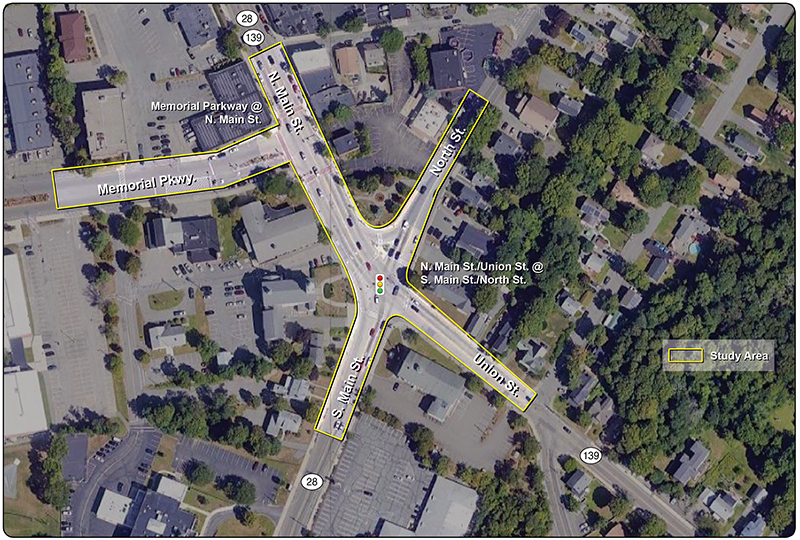
Technical Memorandum
TO: Michelle Tyler, Town of Randolph
FROM: Julie Dombroski, Boston Region MPO Staff
RE: Safety and Operations Analyses at Selected Intersections, FFY 2022—Crawford Square and Memorial Parkway at Route 28/139 in Randolph
This memorandum summarizes the analyses and improvement strategies for the intersection known as Crawford Square, as well as the intersection of Memorial Parkway and North Main Street (Route 28 and Route 139).
This memorandum contains the following sections:
The memorandum also includes technical appendices that contain data and methods applied in the study.
The purpose of the “Safety and Operations Analyses at Selected Intersections” studies is to examine safety, operations, and mobility issues at major intersections in the Boston Region Metropolitan Planning Organization’s (MPO) planning area, particularly on arterial highways where many crashes occur, congestion during peak traffic periods may be heavy, or improvements for bus access and for those who walk or bike are needed.
For more than 10 years, the MPO has been conducting these planning studies with municipalities in the region. The communities find the studies beneficial, as they provide an opportunity to begin looking at the needs of problematic locations at the conceptual level before municipalities commit funds for design and engineering. Eventually, if a project qualifies for federal funds, the study’s documentation will also be useful to the Massachusetts Department of Transportation (MassDOT) and its project-development process.
These studies support the MPO’s visions and goals, which include increasing transportation safety, maintaining the transportation system, advancing mobility, and reducing congestion.
Figure 1
Study Area

The intersections studied are located in the town center of Randolph. The first, known as Crawford Square, is the intersection of North Main Street (Routes 139 and 28), Union Street (Route 139), South Main Street (Route 28), and North Street. Directly northwest of Crawford Square is the second intersection, at Memorial Parkway and North Main Street (Routes 139 and 28). There are several safety and operational issues at both intersections.
Most of the land adjacent to the study area is zoned in two districts: the Residential Single-Family High-Density District and the Crawford Square Business District. A few parcels near the study area are zoned as Business Professional Districts and Residential Multi-Family Districts. A majority of the parcels north of the study area contain various stores, restaurants, and banks. Single-family residences make up the majority of land use south and east of the study area. Randolph High School is located on Memorial Parkway, just west of the North Main Street and Memorial Parkway intersection.
Route 28 is an important connector in the Town of Randolph. Running parallel to and located just east of Route 24, Route 28 can be used as a local alternate route to access Interstate 93 and Milton to the north and Avon to the south. The 3.25 miles of Route 28 between Interstate 93 and Crawford Square is called North Main Street. At Crawford Square, Route 28 continues south as South Main Street until reaching the Avon town line, where the name changes again. In the town of Randolph, Route 28 is a two-lane roadway until it intersects with Oak Street, where it becomes a four-lane roadway north of the intersection. The roadway is classified as a principal arterial and has speed limit of 25 miles per hour in the study area.
Route 139 is a mostly east-west route through the town of Randolph. It connects the town to Stoughton to the southwest and Holbrook to the east. Route 139 intersects with Route 28 about one-quarter mile north of Crawford Square and then the routes separate at Crawford Square. At the intersection, Route 28 follows South Main Street and Route 139 follows Union Street. The roadway is classified as a principal arterial and has a speed limit of 30 miles per hour in the study area.
Memorial Parkway is a 1,400-foot section of roadway that connects Highland Avenue on its western end to North Main Street on its eastern end. Randolph High School sits on the southern side of Memorial Parkway and Randolph Plaza sits on the northern side. The main entrances to the school and shopping plaza are both located on Memorial Parkway. The roadway is classified as a minor road and has a speed limit of 20 miles per hour in the study area.
Crawford Square is a four-leg, signalized intersection. The southeast-bound approach (North Main Street) widens to three lanes from two—one lane to accommodate each traffic movement. The southwest-bound approach (North Street) has a channelized right-turn lane, and two through lanes, one of which accommodates left-turning vehicles. The northwest-bound approach has two lanes—one for through and left-turning vehicles, and the other for through and right-turning vehicles. Lastly, the northeast-bound approach has a left-turn exclusive lane and a through-right lane. There is a crosswalk on each leg of the intersection, including across the slip lane on the southwest-bound approach. Pedestrian movements are actuated via push buttons.
The three-leg intersection of Memorial Parkway and North Main Street is signalized. Each approach at the intersection has two lanes. The eastbound approach has a left-turn lane and a right-turn lane. The northbound approach has a through-left lane and a through lane. The southbound approach has a through lane and a through-right lane. Crosswalks exist on each approach at this intersection. Pedestrian movements are actuated via push buttons and have an exclusive phase.
Three bus services serve Crawford Square: MBTA bus Routes 238 and 240, and Brockton Area Transit (BAT) bus Line 12. These routes and their variants operate on all four of the intersection approach roadways. MBTA Route 238 connects Holbrook/Randolph Station to Quincy Center Station. MBTA Route 240 connects Avon Square to Ashmont Station. BAT Line 12 provides a connection between Ashmont Station and Brockton (BAT Center Station and Campello Station).
Sidewalks varying between five and eight feet in width are located immediately adjacent all study intersection roadways. At the intersection of Memorial Parkway and North Main Street, crosswalks are present on each leg. The crossings are raised red brick and each curb ramp has grey detectable-warning pavers. Pedestrian push buttons are used to initiate the traffic signals’ pedestrian-crossing phase. The intersection of North Main Street and North Street also has pedestrian crossings on each leg, including on the slip lane on North Street. The crosswalks are marked on the pavement with ladder-style white striping and grey detectable-warning pavers. As at the other intersection, grey detectable-warning pavers are on each curb ramp, and the pedestrian phase is actuated by push buttons. The slip lane on North Street is not a part of the pedestrian phasing at this intersection.
There are currently no bicycle accommodations present in the study area.
Boston Region MPO staff prepared and conducted a survey to help determine the public’s opinion about the issues and problems in the study area, and to gather ideas for resolving them. The online survey was posted on the Boston Region MPO’s website and social media channels, as well as on the Town of Randolph’s website and social media channels. The survey received 426 responses between July 6 and July 29, 2022.
The survey contained the following questions:
Questions 1 through 7 allowed multiple-choice responses and offered respondents the option of writing in a response (in the “Other” choice line). Question 8 asked for a single answer, while Question 9 required a written response. The number and percentage of answers to each question and respondents’ written comments are summarized in Appendix E.
Question 8 was designed to understand the geographical distribution of the
respondents. About 91 percent (361 respondents) of those who answered Question 8 live in Randolph. The rest of the respondents are mostly from neighboring communities—Avon, Braintree, Canton, Holbrook, Milton, Quincy, and Stoughton. A handful of responses came from other nearby areas.
Question 9 was a free-response question for the respondents to describe further viewpoints and to cover the problems and improvement ideas that the survey
answers might not have included. Question 9 received 212 responses. Those comments are listed verbatim in Appendix E.
The following list includes notable conclusions drawn from the survey:
Feedback from the survey was helpful to gauge community concerns and to
solicit ideas for solutions to the existing problems. These ideas were
considered when developing the improvement alternatives discussed in
Section 7.
Based on MPO staff’s field observations, discussions with Town officers, public survey results, and analyses of crash data and existing operations, major issues and concerns at the intersection include the following:
Although the study area is not on a top crash location list, it has a higher-than-average crash rate compared to other signalized intersections in MassDOT Highway District 6.
Both intersections in the study area carry high traffic volumes during the AM and PM peak periods during the week. This volume includes traffic due to school start and release times. Queues form frequently during these hours and pour into the center of each intersection.
Permissive left-turn phases on South Main Street and North Main Street cause delays and lead to vehicles blocking the intersection.
Existing pedestrian infrastructure is relatively adequate and meets Americans with Disability Act (ADA) standards. However, field observations and survey results note that short clearance times, obstructed visibility of crossings, and illegal right-turn-on-red movements that endanger people walking in both intersections.
Crash data analysis is essential to identify safety and operational problems at an intersection. Analyzing data on the frequency of crashes, types and patterns of collisions, and the circumstances under which crashes occur, such as the time of day and roadway surface conditions, also helps to develop improvement strategies.
MPO staff used the most recent six-year crash reports (January 2015–December 2021) for this study. Typically, five years of crash data is used, but an additional year of crash data was collected in order to account for the COVID-19 pandemic effects on vehicular travel in 2020. In total, there were 125 crashes in the recent six-year period in the study area. The majority of crashes occurred at the Crawford Square intersections, but the intersections of Memorial Parkway at North Main Street and Union Street at South Street, as well as Turner Lane at North Main Street were also high-crash areas.
The predominant crash types were angle crashes (41 total), rear-end crashes (35 total) and sideswipe, same-direction crashes (24 total). The remaining 25 crashes were 13 head-on, seven (7) single vehicle, and five (5) sideswipe, opposite direction. Table 1 summarizes the 125 crashes in terms of severity, collision type, pedestrian or bicycle involvement, time of the day, and weather and pavement conditions. Forty-two crashes (34 percent) caused personal injuries with no fatalities.
Fifty-five crashes (44 percent) occurred during peak periods (7:00 AM–10:00 AM and 2:30 PM–6:30 PM). School release schedules were accounted for when establishing peak hours, which resulted in an afternoon peak period of four hours, rather than three. More than a third (38 percent) of the collisions occurred during dark conditions.
Table 1
Crash Data Summary
| Crawford Square and Memorial Drive at N. Main Street | ||||||||||
| Statistics Period | 2015 | 2016 | 2017 | 2018 | 2019 | 2020 | 2021 | 6-Yr. Total | Annual Avg. | |
| Total number of crashes | 18 | 28 | 21 | 14 | 23 | 13 | 8 | 125 | 20.8 | |
| Severity | Property damage only | 13 | 19 | 15 | 9 | 15 | 7 | 5 | 83 | 13.8 |
| Non-fatal injury | 5 | 9 | 6 | 5 | 8 | 6 | 3 | 42 | 7.0 | |
| Fatality | 0 | 0 | 0 | 0 | 0 | 0 | 0 | 0 | 0.0 | |
| Not reported/unknown | 0 | 0 | 0 | 0 | 0 | 0 | 0 | 0 | 0.0 | |
| Collision type | Single vehicle | 1 | 3 | 0 | 0 | 3 | 0 | 0 | 7 | 1.2 |
| Rear-end | 8 | 4 | 9 | 3 | 5 | 5 | 1 | 35 | 5.8 | |
| Angle | 7 | 9 | 6 | 4 | 5 | 6 | 4 | 41 | 6.8 | |
| Sideswipe, same direction | 0 | 7 | 5 | 4 | 6 | 1 | 1 | 24 | 4.0 | |
| Sideswipe, opposite direction | 1 | 2 | 0 | 0 | 1 | 0 | 1 | 5 | 0.8 | |
| Head-on | 1 | 3 | 1 | 3 | 3 | 1 | 1 | 13 | 2.2 | |
| Rear-to-rear | 0 | 0 | 0 | 0 | 0 | 0 | 0 | 0 | 0.0 | |
| Not reported/unknown | 0 | 0 | 0 | 0 | 0 | 0 | 0 | 0 | 0.0 | |
| Involved pedestrian(s) | 0 | 0 | 1 | 0 | 1 | 0 | 0 | 2 | 0.3 | |
| Involved cyclist(s) | 0 | 0 | 0 | 0 | 0 | 0 | 0 | 0 | 0.0 | |
| Occurred during weekday peak periods* | 6 | 13 | 12 | 8 | 10 | 5 | 1 | 55 | 9.2 | |
| Wet or icy pavement conditions | 4 | 4 | 2 | 2 | 4 | 6 | 3 | 25 | 4.2 | |
| Dark conditions (lit or unlit) | 9 | 10 | 8 | 5 | 6 | 5 | 4 | 47 | 7.8 | |
| * Peak periods are defined as 7:00a–10:00a and 2:30p-6:30p. | ||||||||||
Based on the police reports, staff constructed a collision diagram (Figure 2) that shows the locations and patterns of all the crashes in the study area. The information about each crash, including date, time, severity, collision type, most harmful event, weather conditions, and driver contributing code are summarized in Appendix A.
Figure 2
Collision Diagram: Crawford Square in Randolph
Police Crash Reports 2015-21
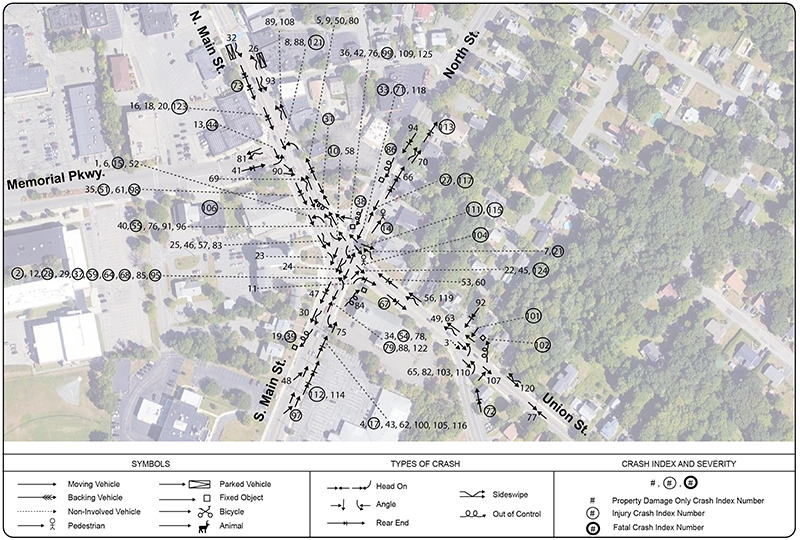
To examine the existing conditions, MPO staff requested MassDOT’s assistance in collecting Automatic Traffic Recorder (ATR) counts on the approaching roadways and intersection turning movement counts (TMCs) for this study. The ATR counts were performed during the week of May 10–16, 2022. The TMCs were collected Thursday, May 12, 2022.
Based on the data, staff estimated the average weekday traffic volumes in roadway sections near the study intersections as follows:
MassDOT collected turning movement counts at the study intersections on Thursday, May 12, 2022, during the morning peak period (7:00 AM–10:00 AM) and the evening peak period (2:30 PM–6:30 PM), and on Saturday, May 14, 2022, during the midday peak period (10:00 AM–2:00 PM).
Staff adjusted TMC data using a 2019 MassDOT seasonal adjustment factor of 0.93 for an urban (U3) roadway.
Figures 3 and 4 summarize the adjusted 2022 AM and PM peak-hour traffic turning volumes by approach at each intersection.
Figure 3
Adjusted Peak-Hour Counts
Crawford Square in Randolph
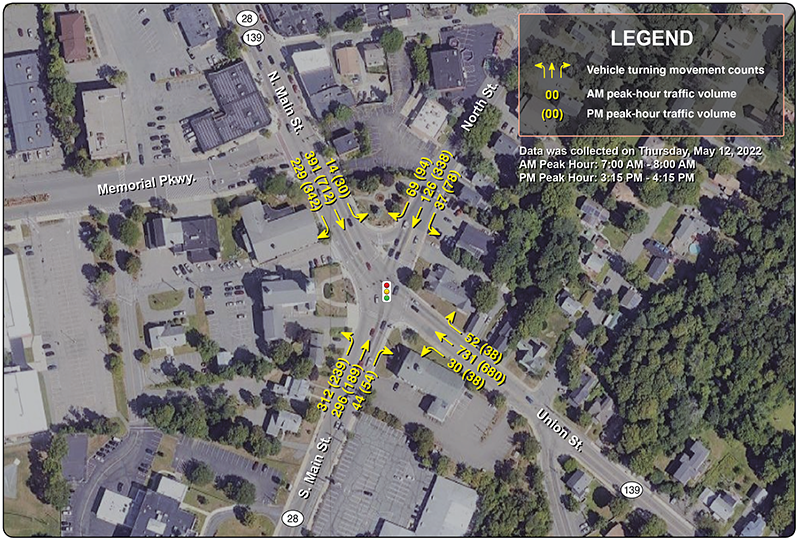
Figure 4
Adjusted Peak-Hour Counts
North Main Street (Routes 28/139) at Memorial Parkway in Randolph
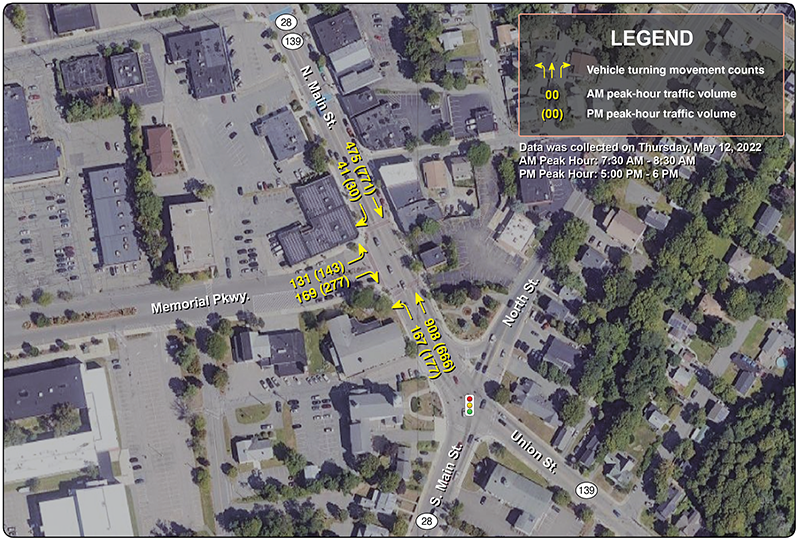
Based on the estimated 2022 AM and PM peak-hour turning movements, staff conducted the intersection capacity analysis for the two study intersections by using the Synchro traffic analysis and simulation program. 1
Staff conducted traffic operations analyses consistent with the Highway Capacity Manual (HCM) methodologies (included in Appendix C). HCM methodology demonstrates driving conditions at signalized and unsignalized intersections in terms of level-of-service (LOS) ratings from A through F. LOS A represents the best operating conditions (little to no delay), while LOS F represents the worst operating conditions (very long delay). LOS E represents operating conditions at capacity (limit of acceptable delay). Tables 2 and 3 present the control delays associated with each LOS for the signalized intersections.
Table 2
Summary of Intersection Capacity Analyses
Crawford Square
Adjusted 2022 AM and PM Peak-Hour Traffic Conditions
Analysis Period |
AM |
AM |
AM |
PM |
PM |
PM |
Approach |
LOS |
Delay |
V/C |
LOS |
Delay |
V/C |
Union Street NB |
D |
49.2 |
0.88 |
D |
46.6 |
0.82 |
North Main Street SB |
C |
25.7 |
0.42 |
E |
68.6 |
0.68 |
South Main Street NEB |
D |
40.2 |
0.71 |
D |
36.5 |
0.60 |
North Street SWB |
D |
38.7 |
0.39 |
F |
91.1 |
0.69 |
Intersection Average |
D |
39.3 |
- |
E |
62.1 |
- |
Notes:
Approach: NEB = Northeast-bound. NB = Northbound. SB = Southbound. SWB = Southwest-bound.
All movements share a single lane on all approaches.
AM Peak Hour = 7:00 AM–8:00 AM. PM Peak Hour = 3:15 PM–4:15 PM.
Delay = Average delay per vehicle (seconds).
LOS = Level of service. V/C = Volume to capacity ratio.
Table 3
Summary of Intersection Capacity Analyses
Memorial Parkway at North Main Street
Adjusted 2022 AM and PM Peak-Hour Traffic Conditions
Analysis Period |
AM |
AM |
AM |
PM |
PM |
PM |
Approach |
LOS |
Delay |
V/C |
LOS |
Delay |
V/C |
North Main Street NB |
E |
77.2 |
0.88 |
E |
76.4 |
0.85 |
North Main Street SB |
C |
22.2 |
0.42 |
C |
26.2 |
0.64 |
Memorial Parkway EB |
C |
24.4 |
0.79 |
C |
21.2 |
0.87 |
Intersection Average |
D |
52.5 |
- |
D |
44.8 |
- |
Notes:
Approach: NB = Northbound. SB = Southbound. EB = Eastbound.
All movements share a single lane on all approaches.
AM Peak Hour = 7:00 AM–8:00 AM. PM Peak Hour = 3:15 PM–4:15 PM.
Delay = Average delay per vehicle (seconds).
LOS = Level of service. V/C = Volume to capacity ratio.
1 Staff used Synchro Version 10.3, developed and distributed by Trafficware Ltd. It can perform capacity analysis and traffic simulation (when combined with SimTraffic) for an individual intersection or a series of intersections in a roadway network.
Based on the above analyses, MPO staff developed a series of short- and long-term improvements to address safety and operational problems at the intersections. The proposed short-term improvements generally can be implemented within two years at a relatively low cost (usually less than $30,000). The proposed long-term improvements cover larger areas, require intensive planning and design, and require more significant funding. These improvements are analyzed in the next section. The proposed short-term improvements are summarized below, from the lowest to the highest cost:
The proposed long-term improvements would require additional planning and design and more significant funding. Based on the goals of maximizing safety and operational benefits for all transportation modes and minimizing construction impacts, staff identified two alternatives that are more feasible than others.
Staff also analyzed traffic operations for the alternatives and the base case (no-build scenario) under projected 2030 traffic conditions. For comparison purposes, the analysis includes a future year no-build scenario that contains only signal retiming with no geometry modifications and no signal system upgrade.
Key elements of the no-build scenario and the two alternatives are summarized below. Figures 5 and 6 show design alternatives as described below.
The no-build alternative assumes that the intersections would remain the same as the existing conditions. The only improvement included is to retime and coordinate the signals.
Alternative One proposes to modify the layout of Turner Lane and upgrade the signal system for adding bicycle detection. Key elements of the alternative include
Alternative Two proposes to modify the layout of Turner Lane and upgrade the signal system for adding bicycle detection. Key elements of the alternative include
Figure 5
Turner Lane Design Alternatives
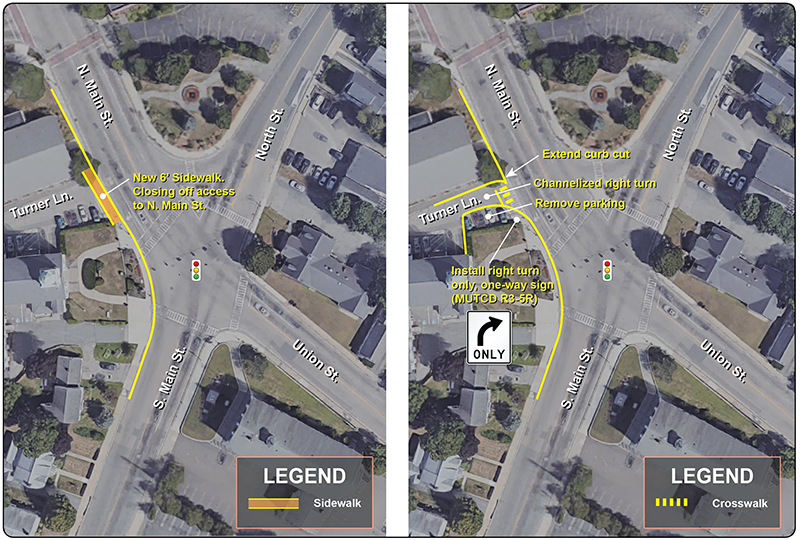
Figure 6
Memorial Parkway
Mid-block Crossing Improvements
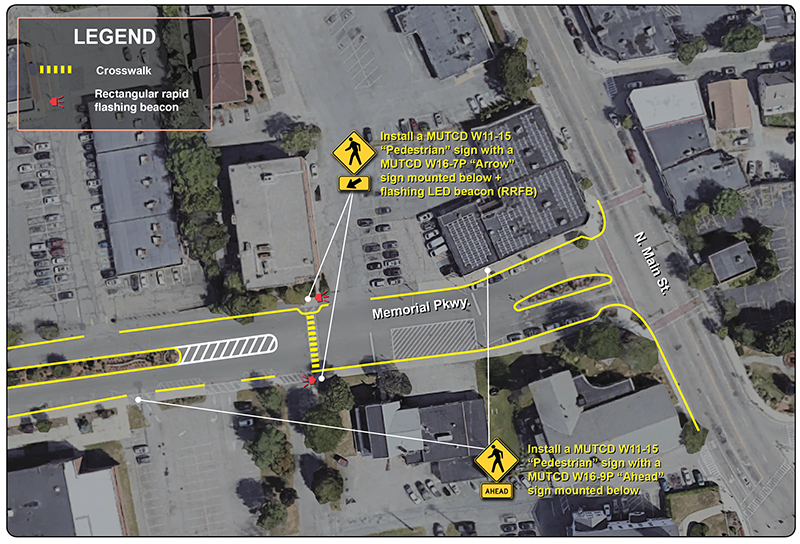
In this study, MPO staff performed a series of safety and operations analyses, identified issues and concerns, and proposed short- and long-term improvements for the intersection at Crawford Square and the intersection of Memorial Parkway and North Main Street. The proposed short-term improvements would enhance safety and operations for the intersections under the existing conditions. These improvements should be implemented as soon as resources are available from
highway maintenance or local Chapter 90 funding.
The proposed long-term improvements would address the safety and operational problems at the intersections. The intersections urgently need retiming and coordination to operate at adequate levels. At this preliminary planning stage, after consulting with Town officials, staff recommend Alternative Two. However, both proposed alternatives should be included and further investigated at the functional design stage of project planning.
The Town of Randolph has jurisdiction of both intersections and shares jurisdiction of roadways in the study area with MassDOT. The Town should work with MassDOT to improve safety, mobility, connectivity, and operations of both intersections. There is the potential for the intersection at Crawford Square and adjacent roadways to better accommodate peak-hour traffic volumes and better serve people walking and biking through the center of Randolph, while reducing collisions. Improving safety and operations at these intersections is one essential component in remediating many of the existing issues in the study area.
This study gives the Town an opportunity to address the needs of each intersection and plan for design and engineering. The next steps would be to select the preferred alternative that is sensitive to the goals and needs of stakeholders and advance the project through the planning process. These steps will depend upon cooperation between MassDOT, the Town, and the MPO to begin MassDOT’s project notification and review process and complete the project initiation form. After completing the initial steps, the Town and MassDOT can start preliminary design and work to have the project programmed in the Transportation Improvement Program. Project development is a process that takes transportation improvements from concept to construction and is influenced by factors such as financial limitations and agency programmatic commitments. (See Appendix D for an overview of this process.)
This study supports the MPO’s visions and goals, which include increasing transportation safety, maintaining the transportation system, advancing mobility and access, reducing congestion, and expanding the opportunities for walking and bicycling, while making them safer. If implemented, the improvements proposed in this report would modernize the roadway and significantly improve safety and mobility of all users.
Appendix A: Crash Diagram Lookup Table
Appendix B: Intersection Capacity Analyses—2022 Adjusted AM and PM Peak Hours
Appendix D: MassDOT Project Development Process
Appendix E: Study Area Survey Results
The Boston Region Metropolitan Planning Organization (MPO) operates its programs, services, and activities in compliance with federal nondiscrimination laws including Title VI of the Civil Rights Act of 1964 (Title VI), the Civil Rights Restoration Act of 1987, and related statutes and regulations. Title VI prohibits discrimination in federally assisted programs and requires that no person in the United States of America shall, on the grounds of race, color, or national origin (including limited English proficiency), be excluded from participation in, denied the benefits of, or be otherwise subjected to discrimination under any program or activity that receives federal assistance. Related federal nondiscrimination laws administered by the Federal Highway Administration, Federal Transit Administration, or both, prohibit discrimination on the basis of age, sex, and disability. The Boston Region MPO considers these protected populations in its Title VI Programs, consistent with federal interpretation and administration. In addition, the Boston Region MPO provides meaningful access to its programs, services, and activities to individuals with limited English proficiency, in compliance with U.S. Department of Transportation policy and guidance on federal Executive Order 13166. The Boston Region MPO also complies with the Massachusetts Public Accommodation Law, M.G.L. c 272 sections 92a, 98, 98a, which prohibits making any distinction, discrimination, or restriction in admission to, or treatment in a place of public accommodation based on race, color, religious creed, national origin, sex, sexual orientation, disability, or ancestry. Likewise, the Boston Region MPO complies with the Governor's Executive Order 526, section 4, which requires that all programs, activities, and services provided, performed, licensed, chartered, funded, regulated, or contracted for by the state shall be conducted without unlawful discrimination based on race, color, age, gender, ethnicity, sexual orientation, gender identity or expression, religion, creed, ancestry, national origin, disability, veteran's status (including Vietnam-era veterans), or background. A complaint form and additional information can be obtained by contacting the MPO or at http://www.bostonmpo.org/mpo_non_discrimination. To request this information in a different language or in an accessible format, please contact Title VI Specialist By Telephone: For more information, including numbers for Spanish speakers, visit https://www.mass.gov/massrelay.
|